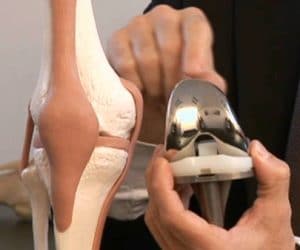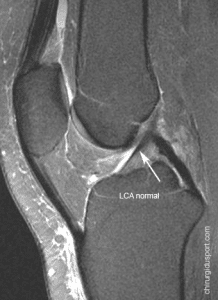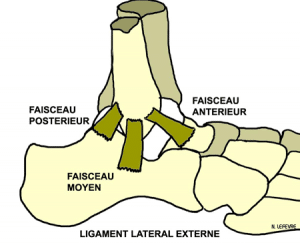Introduction
When accelerating or a shooting, “crack”, you feel a sharp pain in the thigh. You stop your action, sometimes you leave the field limping. This is probably a “breakdown” … or “stretch” … or maybe an avulsion! The doc France soccer explains your injury and its treatment!
What happened ?
Shot perfectly illustrates the constraints muscle in the thigh during football practice. In the end gesture, the knee extends powerfully bends and hip. When the leg up towards the chest, the movement of these joints is associated strongly to pull the muscle on the back of the thigh. Simultaneously, it must contract because he is responsible for the slow movement. It protects the knee of an excess of expansion and control the technical quality of gesture: the tibia below the knee this muscle stretches. He pulls on the fibrous sac that surrounds it. To adjust the shot, the muscle fibers contract and pull on the envelope in the opposite direction! Sometimes the junction points between the fibers and the muscle membrane can give: the muscle injury
A “breakdown”, what is it?
In fact, the injury is more or less severe depending on the extent of damage in the muscle. If contracture is not yet found in the tissue lesion. Following local depletion, a few muscle fibers become blocked, they can no longer relax. You know this: your favorite thriller, the whole body of the corpse stiffens by lack of energy.
When some muscle fibers are torn in contact with the fibrous sac, we speak of “elongation”. Sometimes this muscle shell, called “fascia” is distended. This is called a “breakdown”. When the trauma is more violent, the membrane may open is the “tear”. Finally, the entire bag is torn all around the muscle: you are the victim of a “rupture”.
How to recognize a serious injury?
The envelope contains all the blood vessels that feed the muscle. When broken, the blood spreads into the muscle. It separates the muscle fragments and does not promote the repair of the lesion.
All signs suggesting tearing of the membrane and bleeding are serious elements.
- A cracking or tearing sensation
- Impossible to continue the sport …
- Swelling of the thigh
- possibly followed by a blue streak under the skin. This bruise characterizes the blood flow.
What to do in an emergency, on the ground?
In these circumstances, leave the field. Circle the leg with a tape. Go above the knee and reassemble. Tighten slightly down and then less and less. The clamping decreases bleeding. The more pressure at the base of the thigh promotes the return of blood to the heart. Place an ice pack on the bandage next to the painful area. Leave it in place at least 20 minutes. Remember: when it’s hot, your face is all red. The heat opens the vessels. Conversely, the cold causes closure. Ice reduces bleeding in the muscle. To promote the evacuation of blood to the general circulation, lift the leg. Relax your muscles, lie down and put your foot in height.
To treat emergency muscle damage, install the GREC.
G = ice
R = rest … stop the activity and position reducing muscle tension
E = elevation
C = compression
Please note this is not always a “breakdown”!
Muscle clings to the bone. Sometimes at its violent tensioned, the bone insertion point which is torn off. This type of fracture occurs most often in children or adolescents. The growing bone is fragile, there is a link weaker than muscle.
During the preparation of firing, the muscle located at the front of the thigh is strongly stretched. Stretched to the maximum, it contracts to boost the movement and shooter. So it happens that the docking area on the pelvic bone breaks. The real divide requires specific treatment.
Must we always see a doctor?
If there are signs of severity, medical advice is needed to clarify the extent of injury. An ultrasound may be considered. We must quickly program a suitable treatment. Even if some benign medication and physiotherapy especially are very useful.
How to cure your “breakdown”?
First, it is crucial to continue the fight against the bleeding. Soon rehabilitation is established. The gentle muscle contraction begins when it causes more pain. Even at the beginning of treatment, the muscle work is essential for its proper healing. His movements cause variations in pressure that hunt hematoma. Stretching promotes the formation of a scar softer and more suited to its function. Without working muscle, the bruise heal as a fibrous crust becoming stiff and brittle link in the chain elastic muscle You’ve probably been victim of cracking lips. A rigid skin and cornea repair the injury. A big smile … and “crack” … a new tear is. That’s what you risk the resumption of football if you treat your muscle injury with rest!. The physiotherapist following healing to gradually increase the mechanical stresses. Before allowing the return to the field, he must impose the muscle the same constraints as those experienced in the practice of football!
Even in case of complete rupture, surgery is exceptional. The shredded muscle is very difficult to suture. Better to let the healing clinging to the nearby muscle.
How long will you be unavailable?
Muscle damage without damage to the membrane heals in 1 to 2 weeks. When the muscle is damaged envelope your absence can last 3-8 weeks. But remember: the right amount of muscle activity is part of the treatment. Quickly, swimming, biking and jogging are welcome. Finally, you do not stop the sport, you keep the form to recover as quickly as your name on the scoresheet!
The board: technical training should cease when fatigue sets!
You want to learn and understand a new exercise. If you repeat until muscle exhaustion, the movement is deformed! Soon your nervous system leads to program the action of compensating muscles. Your brain ends up storing a defective gesture! In the jargon of coaches, you “unlearn”.
Eventually the “common sense” joined the opinion of specialists in brain function.
This statement is to modulate for practitioners very “high level”. When the gesture is perfectly assimilated many years, the optimum technical level is reached, the motor patterns are perfectly inscribed in the brain! It may be useful to perform complex exercises beyond fatigue. Under these conditions the right muscles continue to train and advance … to take until the end of the match!
The question: my game is at 14 hours, what should I eat for breakfast?
When the competition takes place early in the afternoon, do not lunch. Prefer a “brunch” plentiful between 10 and 11 hours. You’ve had your fill of energy but you release your stomach for digestion.
If you eat too close to the effort, the gut works during exercise. He asks blood! This amount will not be available for the muscles! Your physical performance deteriorates! Meanwhile, your stomach and intestine work in poor conditions. They also lack the blood because the muscle needs. In addition, they are shaken when you run! They are quick to suffer!
In practice, in your “brunch”, put cereal, cottage cheese 0 or 20% fat and a compote or fruit juice. wholemeal bread toast with a little butter and jam, along with a large bowl of milk are suitable if you tolerate them well. You can add a small slice of lean ham or a piece of chicken without the skin. Avoid fried eggs and bacon, too fat for the occasion.
Stéphane doctor also gives you information on: www.sportsante.info



